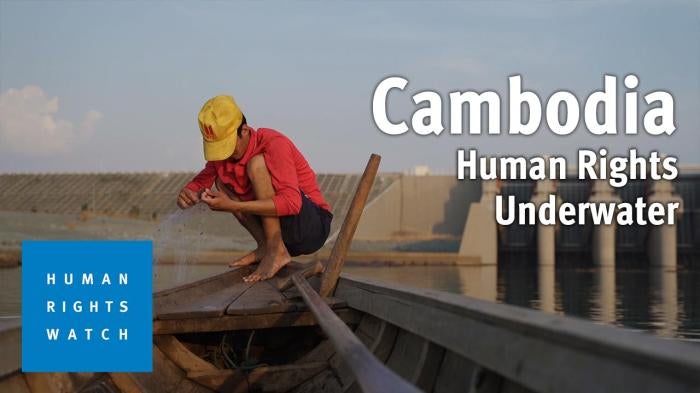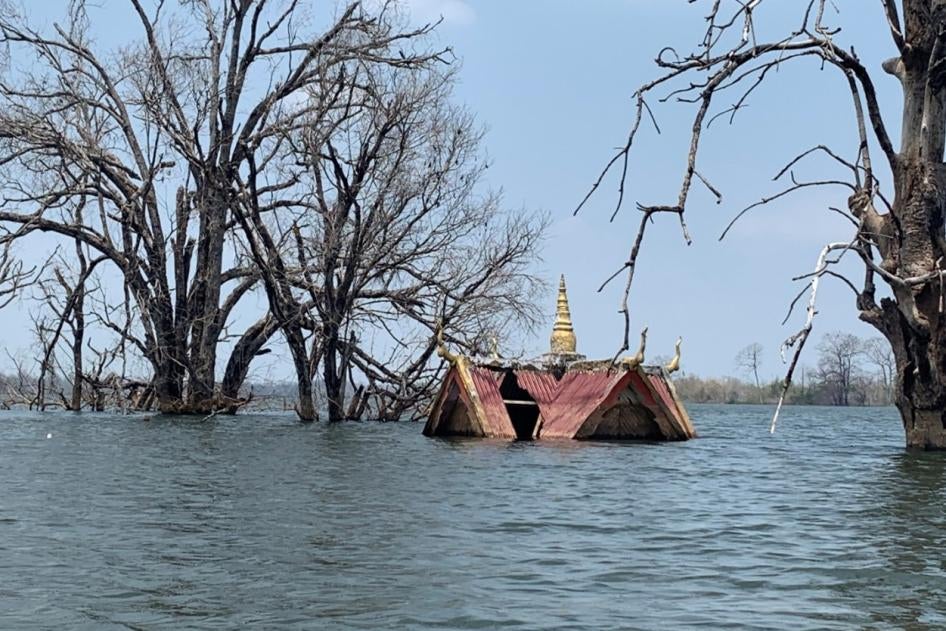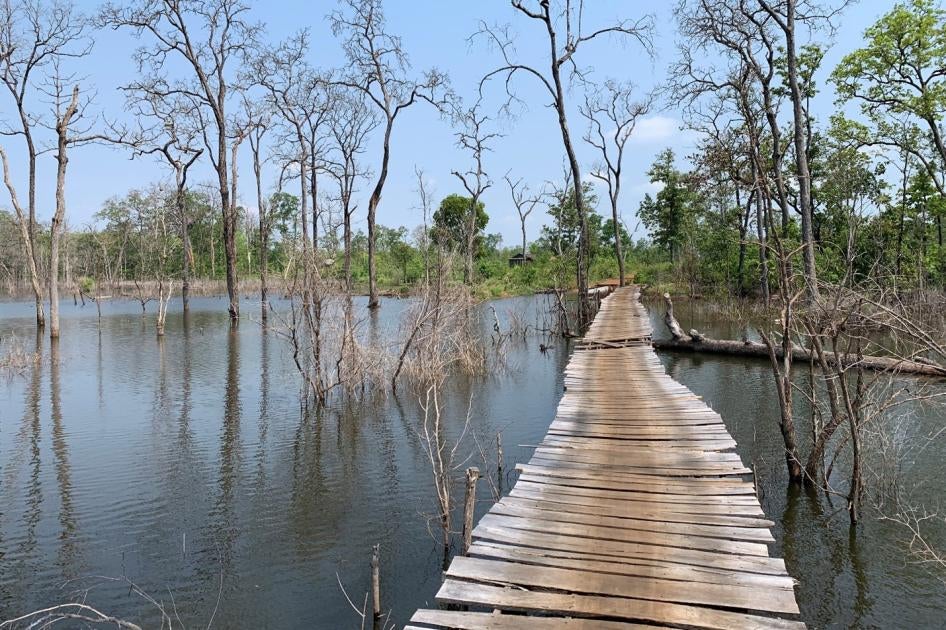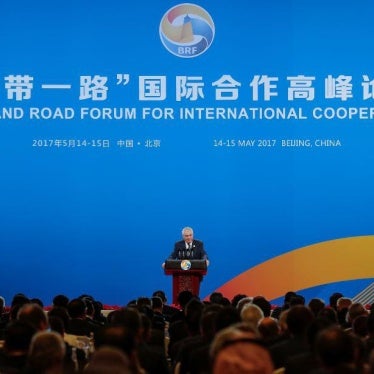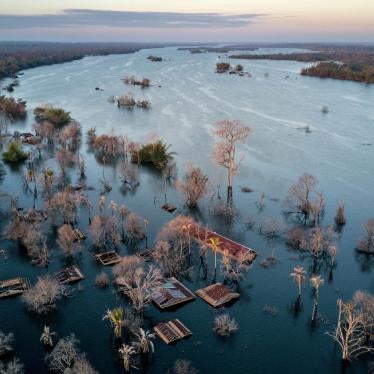(Bangkok) – A large-scale, Chinese-financed hydroelectric dam in northeastern Cambodia, completed in 2018, has undermined the lives and livelihoods of thousands of Indigenous and ethnic minority people, Human Rights Watch said in a report released today. The Lower Sesan 2 dam, one of Asia’s widest dams, flooded large areas upstream of the confluence of the Sesan and Srepok Rivers, two tributaries of the Mekong River.
The 137-page report, “Underwater: Human Rights Impacts of a China Belt and Road Project in Cambodia,” documents economic, social, and cultural rights violations resulting from the Lower Sesan 2 dam’s displacement of nearly 5,000 people whose families had lived in the area for generations, as well as impacts on the livelihoods of tens of thousands of others upstream and downstream. Cambodian authorities and company officials improperly consulted with affected communities before the project’s start and largely ignored their concerns. Many were coerced into accepting inadequate compensation for lost property and income, provided with poor housing and services at resettlement sites, and given no training or assistance to secure new livelihoods. Other affected communities upstream and downstream of the dam received no compensation or assistance.
“The Lower Sesan 2 dam washed away the livelihoods of Indigenous and ethnic minority communities who previously lived communally and mostly self-sufficiently from fishing, forest-gathering, and agriculture,” said John Sifton, Asia advocacy director. “Cambodian authorities need to urgently revisit this project’s compensation, resettlement, and livelihood-restoration methods, and ensure that future projects don’t feature similar abuses.”
Human Rights Watch interviewed more than 60 community members, civil society leaders, academics, scientists, and others who have researched the project; and reviewed academic studies, business records, and research by nongovernmental organizations and other sources.
The dam is part of the Chinese government’s “Belt and Road Initiative” (BRI), an enormous multinational infrastructure project begun under President Xi Jinping in 2013. Many of these projects in Asia and elsewhere have faced criticism for lack of transparency, disregard of community concerns, and negative environmental impacts.
China Huaneng Group, a large Chinese state-owned electricity generation company, built and operates the dam. Cambodia’s Royal Group and Vietnam’s state-owned electricity company, EVN, hold minor stakes. Chinese government banks provided most of the financing, reportedly budgeted at approximately US$800 million.
Cambodian government and company officials failed to genuinely consult with affected communities and made no attempt to obtain the “free, prior, and informed consent” of Indigenous peoples, as specified in the United Nations Declaration on the Rights of Indigenous Peoples.
The Indigenous peoples and other ethnic minorities affected by the project include members of Bunong, Brao, Kuoy, Lao, Jarai, Kreung, Kavet, Tampuan, and Kachok communities.
From 2011 through the dam’s completion in 2018, community members protested and wrote numerous letters to company and government officials, including Prime Minister Hun Sen, but officials repeatedly dismissed community concerns and resisted discussions of alternatives. Some who objected were threatened or even jailed.
“The company didn’t consider Indigenous rights,” one Bunong villager told Human Rights Watch. “They just told us to move.”
“In the consultation, they determined things for us,” one villager said. “They didn’t ask us what we want or need.”
The dam has had a major impact on fishing income. By preventing numerous types of fish from completing migrations vital to their reproduction process, it has resulted in steep decreases in fishery yields. Fishery and ecology experts have reported that the dam is contributing to decreases in fishery yields across the entire Mekong River system, on which tens of millions of people in Cambodia, Vietnam, Thailand, and Laos rely for food and income.
“Now fish are so scarce,” said one man living near the dam. “We used to get fish for eating and selling, but [now] it has completely decreased. We sometimes don’t even have enough to eat.”
Resettled villagers said their agricultural yields also decreased due to the less fertile, more rocky soil at resettlement sites, and lost income from fruit and nut trees in their old villages. The government provided no compensation for losses to income from mushrooms, medicinal plants, and other products gathered from communal forests. Compensation was inadequate to address losses of Indigenous culture and livelihood. Well water at most of the resettlement sites was contaminated and undrinkable.
China Huaneng did not set up any effective grievance mechanisms to resolve disputes or complaints, Human Rights Watch said.
Several hundred villagers did not accept compensation or resettlement in 2017 but instead moved to nearby unoccupied land along the new reservoir created by the dam. Local authorities intimidated and harassed these villagers.
Neither Chinese nor Cambodian authorities nor China Huaneng appear to have conducted meaningful assessments of the project’s benefits versus impacts prior to construction. China Huaneng has repeatedly claimed the dam can produce 1,998 gigawatt hours per year, about one-sixth of Cambodia’s entire annual electricity production. The dam’s actual production, however, is likely less than half of that, based on reported estimates of the project’s tax revenue.
The dam provides minimal environmental benefits. Numerous academic studies have shown that emissions from decomposing vegetative matter submerged by dam reservoirs often rival production of greenhouse gasses by ordinary fossil fuel power plants. A 2017 study estimates that the project has a carbon dioxide emission rate per megawatt hour comparable to some natural gas plants.
Human Rights Watch wrote to Chinese and Cambodian government officials and China Huaneng in March 2020 and May and July 2021, outlining its findings and seeking responses, but received no replies. A 2020 “Sustainability Report” about the dam commissioned by China Huaneng and released in May 2021 acknowledges many of the dam’s problems but downplays their severity and concludes, without clear explanation, that the project improved the lives of displaced people. The report does not discuss the dam’s impacts on the livelihoods of communities upstream and downstream of flooded areas.
China Huaneng and the Cambodian government can still address some of the project’s harms, mainly by conducting new assessments for compensation and providing more services and training for communities affected by the dam. The governments of China and Cambodia should also undertake more systemic reforms to avoid abuses in future projects.
“The Chinese government needs to drastically reform Belt and Road infrastructure development financing to prevent abuses in other projects undertaken in countries like Cambodia, where the government has a long track record of violating its citizens’ rights,” Sifton said. “The Cambodian government needs to reform its laws to require meaningful impact assessments for development projects and put in place more effective measures to prevent abuses.”
